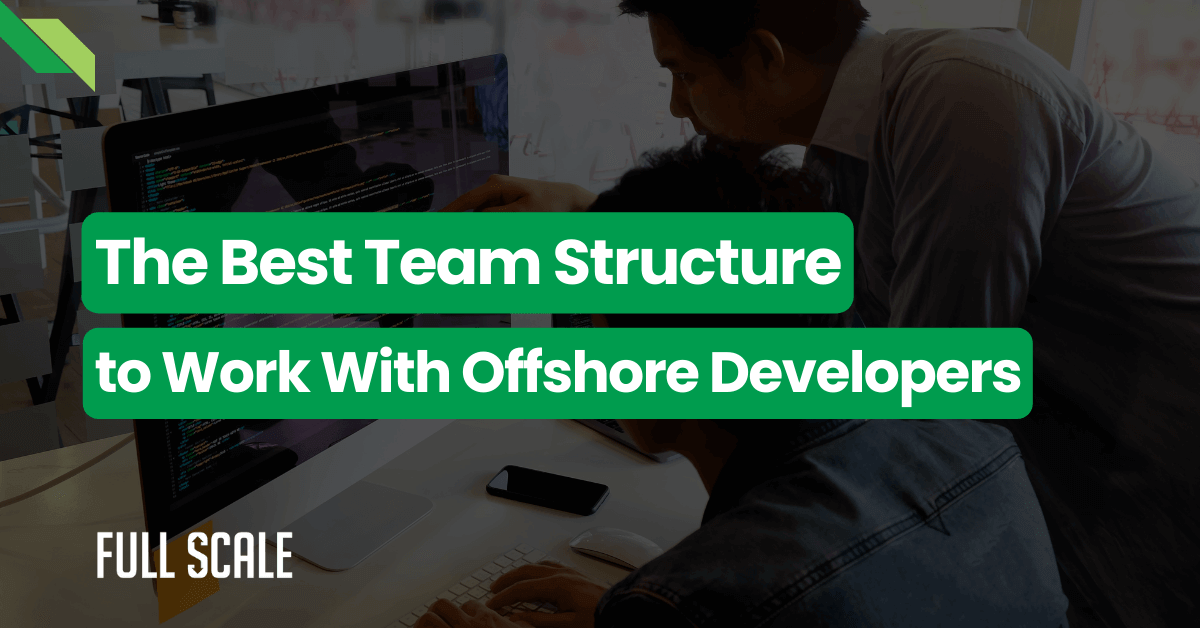Last Updated on 2025-11-11
Your CEO doesn’t care about staff augmentation. They care whether this makes them look smart to the board. Walk in talking about “offshore developers” and “cost savings,” and you’ve already lost.
To explain staff augmentation to your CEO, lead with outcomes, not methods. Say “Here’s how we scale engineering 3X faster without tripling payroll” instead of “Let’s hire offshore.” Address quality (95% retention rate), communication (direct Slack integration), and cost (60% savings) upfront. Frame it as a competitive advantage, not cost-cutting.
I’ve pitched this from both sides of the table. Here’s what actually works when you explain staff augmentation to your CEO.
What You'll Learn in This Guide
- The CEO Translation Table — What executives really mean when they object
- The 4-Part Positioning Framework — How to frame staff augmentation as competitive advantage
- ROI Calculator — Calculate exact savings for your CEO conversation
- 5 Objection Scripts — Pre-built responses for every CEO concern
- Real CEO Conversations — What actually worked for 3 CTOs who got approval
What Your CEO Is Really Worried About
According to a 2024 Gartner survey, 72% of executives cite “perception risk” as their primary concern with distributed hiring—not technical capability. The fear isn’t about whether offshore developers can code. It’s about whether this decision signals weakness to the board.
| What They Say | What They Mean | Your Response |
|---|---|---|
| "What about quality?" | "Will this embarrass me?" | "95% retention vs 60% average" |
| "Communication barriers?" | "Will this slow us down?" | "Same Slack/standups/sprints" |
| "What about hidden costs?" | "Are we actually saving money?" | "$80K all-in vs $260K local" |
| "Why can't we hire locally?" | "Are we admitting defeat?" | "Expanding pool, not replacing" |
The 4-Part Framework to Explain Staff Augmentation
Wrong approaches kill this conversation before it starts. Here’s how to fix it when you explain staff augmentation to your CEO.
❌ Wrong Way
“We should consider offshore developers because hiring locally is expensive and takes too long.”
Why it fails: Defensive, reactive, desperate.
✅ Right Way
“Here’s how we hit our Q3 roadmap while competitors are stuck in salary bidding wars—without compromising quality or control.”
Why it works: Strategic, proactive, competitive.
- Don't say: "Let's try staff augmentation"
- Say: "Here's how we deliver the roadmap on time and under budget"
- Don't say: "Offshore is cheaper"
- Say: "We're accessing 50,000 developers while competitors fight over 500"
- Don't say: "Let's experiment"
- Say: "Month-to-month contracts, 2-week trials, zero long-term risk"
- Don't say: "We can't find local talent"
- Say: "Core team stays local—we're augmenting for specialized roles"
If you say “offshore” in the first 30 seconds, you’re doing it wrong. Lead with the problem you’re solving.
Calculate Your Real Cost Savings
Run these numbers before you walk into that CEO conversation. This calculator shows the all-in cost comparison your executive team actually cares about.
Staff Augmentation ROI Calculator
Annual Cost Comparison
Ready to build your team?
Start Hiring Developers →See our detailed pricing breakdown and run your actual numbers before the meeting.
5 Ways to Explain Staff Augmentation to Your CEO
Every CEO asks these five questions. Prepare your answers now, not in the moment.
Objection 1: “What about communication barriers?”
What they’re really asking: “Will this slow our velocity?”
“That’s why we avoid traditional outsourcing. With staff augmentation, developers are in your Slack, standups, and sprint planning—identical to local employees. After 2 weeks of onboarding, Full Scale clients report zero difference in communication speed.”
Objection 2: “Isn’t this just outsourcing?”
What they’re really asking: “Are we repeating past mistakes?”
| Aspect | Outsourcing | Staff Aug |
|---|---|---|
| Relationship | Vendor | Employee |
| Communication | Via PM | Direct |
| Duration | Project-based | Long-term |
| Turnover | 40% | 5% |
Different model, different results.
Objection 3: “What’s the real cost?”
What they’re really asking: “Is this a budget trap?”
All-in annual cost per senior developer:
- Local: $180K salary + $50K benefits + $30K recruiting = $260K
- Staff aug: $70K + $10K placement = $80K
- Savings: $180K per developer annually
According to Deloitte’s 2024 Global Outsourcing Survey, staff augmentation models show 58% lower TCO versus local hiring.
Additionally, 95% retention means you’re not paying $ 30,000 every 18 months for replacements. See complete pricing.
Objection 4: “How do we ensure quality?”
What they’re really asking: “Will this tank our product?”

500+ developers placed across 60+ tech companies. 95% retention rate versus 60% industry average. These are senior engineers, not juniors.
Objection 5: “Why not just hire locally?”
What they’re really asking: “Are we giving up on being top-tier?”
“We’re not replacing local hiring—we’re augmenting strategically. Core leadership stays local. Netflix has distributed teams across 50+ countries. GitLab is 100% remote in 65+ countries. Automattic has been distributed since 2005. Are they second-tier? No—they’re smart about global talent access.”
The closer: “Competitors are stuck bidding on 200 Bay Area developers. We’re accessing 50,000 globally. Who ships faster?”
How 3 CTOs Got CEO Approval (Real Conversations)
Example 1: SaaS CTO — The Roadmap Play
The pitch: One slide: “How We Hit Q3 Without Hiring 10 Engineers.” Showed: 3 local + 5 staff aug = half the cost of 8 local. Same output.
CEO response: “Why didn’t we start this six months ago?”
Key move: Led with roadmap delivery, not hiring methodology. The CEO never heard “offshore” until slide three.
Result: Scaled 2 to 12 developers in 6 months. Shipped three major features ahead of schedule.
Example 2: FinTech VP — The Security Pre-Empt
The pitch: Led with compliance docs first—SOC 2, ISO 27001, US-based contracts. Killed the security objection before it started.
CEO response: “If compliance is handled, I don’t care where they sit.”
Result: 8 offshore developers, zero security incidents in 18 months.
Example 3: E-Commerce CTO — The Language Reframe
The pitch: Never said “offshore.” Said “accessing top React developers who aren’t competing in the SF job market.”
CEO response: “If this gets us to market faster, I don’t care if they’re on the moon.”
Result: Scaled team 2X in four months. Beat the top three competitors to market.
Pattern: Nobody led with “offshore.” They led with business outcomes.
What to Bring to the CEO Meeting
Don’t walk in empty-handed:
- ROI One-Pager: Cost comparison, 3-year TCO
- Risk Plan: Month-to-month contracts, 2-week trials, 95% retention
- Vetting Process: 3% acceptance, senior-level requirements
- Competitive Intel: 2-3 competitors using distributed teams
- Integration Plan: Same tools, same processes, same standards
Pro tip: Title it “Q3 Engineering Scaling Strategy,” not “Offshore Proposal.”
Why Partner With Full Scale
When you explain staff augmentation to your CEO, they’ll ask, “Why this company?“
What makes Full Scale different:
- 95% retention rate — 58% better than the 60% industry average
- 500+ placements — Proven across 60+ tech companies
- 3% acceptance rate — We reject 97 of 100 applicants
- Senior developers only — 5-10+ years experience required
- Direct integration — Your Slack, your standups, zero middlemen
- Month-to-month flexibility — No long-term traps
- 2-week trials — Prove fit before full commitment
- US-based contracts — IP protection built for American companies
- SOC 2 & ISO 27001 — Enterprise security for regulated industries
According to Clutch’s 2024 B2B Report, Full Scale ranks in the top 3% globally for client satisfaction.
We’re not the cheapest. We’re the option that works when you need senior talent integrated directly—without communication breakdowns, quality issues, and turnover.
Ready to Get CEO Approval?
You’re going to have this conversation eventually. Might as well go in prepared. We’ve helped 60+ CTOs explain staff augmentation to their CEOs and get approval.
Explain it as “hiring full-time employees where payroll is handled by a partner, but developers work exclusively for you.” Don’t lead with geography or cost—lead with control and integration. Emphasize that these are your developers in your Slack and standups, managed by your team leads. Key difference from contractors: dedicated, long-term team members.
Leading with “offshore developers” or “cost savings” in the first 30 seconds. Your CEO thinks “quality compromise” or “desperate move.” Instead, lead with the business problem: “Here’s how we hit our roadmap without 90-day hiring cycles.” Frame it as a competitive advantage. Save the cost discussion for when they ask.
Most CTOs get approval within 1-2 conversations with the right positioning. Timeline depends on: addressing risks upfront, bringing supporting documentation (ROI, vetting process, case studies), and having the CFO buy-in. Well-prepared companies move from the first conversation to an approved budget in 2-3 weeks.
Yes, if your CEO had bad experiences. Don’t avoid it. Say: “I know we tried outsourcing in 2019, and it didn’t work. That was project-based with PM middlemen. This is staff augmentation—different model, different results.” Show the comparison table. Addressing failures builds credibility.
Reframe immediately: “Netflix, GitLab, and Automattic all use distributed teams. Are they cheap? No—they’re smart about talent access. The question isn’t where developers sit—it’s whether we ship faster than competitors stuck in local hiring wars.” Use competitive positioning to shift from “cost-cutting” to “competitive advantage.” Mention that core leadership stays local.




